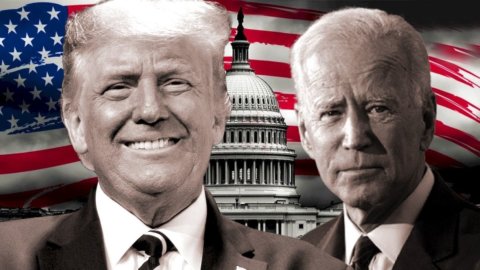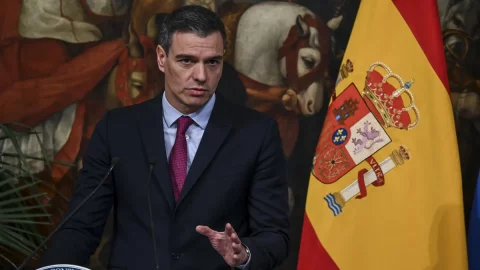Those of November 3 in the United States will be particularly uncertain presidential elections due to the pandemic, which is affecting not only the electoral campaign itself (the incumbent president Donald Trump tested positive) but also the climate and content of the public debate. They will also be, according to forecasts, among the most attended in history, thanks to the impetus of the Black Lives Matter protests and to the movement More Than A Vote, supported by some sports and entertainment stars precisely to guarantee access to the vote for everyone, especially the most marginalized communities. This could theoretically benefit Democratic candidate Joe Biden, former deputy to Barack Obama and currently favored by the polls (with an 8,5-point lead in polling average at the time of writing).
The Intesa Sanpaolo Study Center is also analyzing the scenario of the US vote predicts a Biden victory with Congress divided as the most probable scenario (45%), followed by a Trump victory with Congress divided (30%), by a "democratic sweep" (i.e. full victory of the dem, 20% probability) and by a "republican sweep" very unlikely (5%). Intesa Sanpaolo then scrutinized the electoral programs of the two candidates, especially on economic issues, which are rarely talked about, giving priority to the controversies over Covid or to racial and international political issues. Instead, there would be much to say about fiscal policy and measures to revitalize an economy literally devastated by the crisis (GDP lost a third of its value in the second quarter): meanwhile, the two programs have in common an expansionary impact on the deficits of the next decade. But they diverge in terms of measures.
MUG AND PUBLIC EXPENDITURE
Trump's agenda can be summed up as “less taxes, less spending”, that of Biden in “more taxes, more spending”. However, the main difference between the candidates' economic manifestos lies in the degree of redistribution between income classes. The Biden plan is based on a redistribution from the very high income classes to the low-middle ones, through interventions both on taxes and on spending. In terms of the expected effects on growth, the Biden plan would more than offset the increase in taxes on high incomes and corporations through the stimulus at the bottom and the increase in infrastructure spending in the first two years of the mandate. The Trump plan instead it is not detailed yet, but the main points can be deduced from the 2021 budget proposal published by the White House in the spring. Here they are, in regards to revenue:
- corporate tax confirmed at 21% (it had been reduced with the reform, from 35%);
- extension of accelerated depreciation of investments;
- tax credits for job creation in the US and the displacement of manufacturing and employment from China;
- taxes on individuals: permanently extend the reduction in rates (largely concentrated on high incomes) expiring in 2025;
- higher deductibles for gift and estate taxes;
- permanent extension of the temporary reduction of the payroll tax withheld by employers (this reduction was implemented by a relatively small proportion of companies), with negative effects on Social Security funds;
- reduction of the capital gains tax from 23,8% to a level between 15 and 18%.
On the side of the exits, the main cuts would concern healthcare, focus on the Medicare program. Assistance would also undergo reductions, both on programs for the temporary support of families in difficulty and on those for support for the disabled. On some items, however, increases are expected: 800 billion for funds relating to transport infrastructures and 190 billion for water and network infrastructures, with the spending peak around 2025. The 2021 budget also envisages a increase in defense spending of 166 billion for the National Defense Strategy, in conjunction with cuts in discretionary ex-defense spending.
Biden instead it supports an increase in revenues of about 3,5 trillion dollars in 4 years, to finance expenditure on infrastructure, health and assistance, education, the environment. Half of that money would come from higher corporate taxes and the other half from higher income taxes. Here you are the main measures, incoming:
- increase of the corporate tax to 28% and of the foreign income taxes of multinationals;
- 2017 reform tax cuts maintained, for incomes below $400, tax rate increase for top incomes (top rate to 39,6%, same as pre-reform) from 37%, rate increase for high-income partnerships, change state tax credits (to make them less adverse to high-tax states);
- doubling the capital gains tax to 39,6% on income above $1 million (these individuals make up the majority of taxpayers who pay this tax).
As for expenses, here are the main chapters (7,4 trillion overall):
- Almost a third of new expenditure is attributed to investments in infrastructure (2,4 trillion), divided between transport (900 billion), support for "Made in USA" (700 billion), energy and environment (490 billion), other structures (300 billion). All outflows for this item are expected in the period 2021-24;
- the second contribution comes from education (2 trillion), to support all levels of education including university (zero fees at public universities for families with income <125 dollars per year);
- support for assistance and social security provides for 1,5 trillion. The greatest expense concerns the introduction of paid periods, up to 12 weeks, for illness and family reasons;
- healthcare spending is expected to increase net by 1,5 trillion, with a strengthening of Obamacare (1,8 trillion) partially offset by cost controls for drug reimbursement and other measures (for approximately 350 billion).
DUTIES AND FOREIGN TRADE
Pretty predictable scenario in case of Trump's re-election: probable continuation of trade tensions both with China (further increases in duties) and – according to Intesa Sanpaolo analysts – with other trading partners, which now have larger deficits due to the diversion of flows from China to other producers.
But Biden's position on China does not differ much from that of the tycoon. The dem candidate has in fact declared that China is a "competitor", which will have to be stemmed with measures that reduce Chinese influence in the fields of technology and artificial intelligence. Biden also declined to say he will lift Trump-imposed tariffs on Chinese imports. However, it is possible that a Biden administration will be less confrontational with China on issues other than economic ones and will be more open to cooperating on climate change and health emergencies.
IMMIGRATION AND RIGHTS
The incumbent president obviously professes the continuation of the hard line to reduce immigration, legal and illegal, with typically populist arguments: immigrants take jobs away from citizens, commit crimes and reduce available resources (schools, healthcare, homes, etc.). During the first term of Trump, the growth of immigrants has slowed to about 750 a year, from a previous annual average of around 1 million, and could fall further to 500 in a second term. Here is the schedule:
- reduction of work visas or stabilization offset by reduction of immigration for family ties;
- increased restrictions on the granting of visas for skilled work (H-1B);
- elimination of protection for immigrants who entered illegally as children (there are around 11 million, currently guaranteed by the DACA, Deferred Action for Childhood Arrivals Program);
- construction of the wall with Mexico
Biden instead it supports the protection of legal immigration. With these arguments:
- increased immigration with work visas and removal of caps for some countries (eg India); maintenance of the lottery for the distribution of a certain number of green cards to countries with low immigration to the US; facilitation of obtaining citizenship for students who studied in the USA;
- lifting of Trump's bans on the entry of individuals from a list of problematic countries; restrictions on H-1 visas (for skilled workers) similar to those wanted by Trump;
- regularization of immigrants who entered illegally as children (DACA);
- establishing a new state and local government sponsored visa program to address labor shortages in specific industries.





